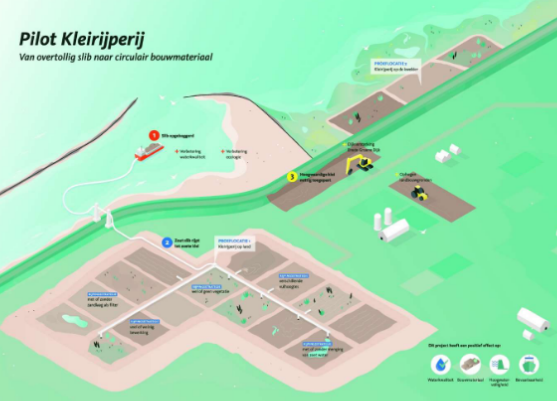Kleirijperij


Environmental issue:
|
Relevance to the 5 Es framework of the ESPO Green Guide:
|
| Title best practice: Pilot Kleirijperij
Description: Too much mud is present in the Eems-Dollard. As a result, the water quality is not sufficient and biodiversity is declining. A lot of mud collects in the ports, which means that dredging is regularly required. On the other hand, there is a need for clay in the area to strengthen dikes and to elevate agricultural land. By extracting mud from the Eems-Dollard and converting it into clay, a win-win situation is created: the water quality improves and clay becomes available for dyke reinforcement and raising agricultural land. In the future, more dyke improvements, that require clay, are planned along the Eems-Dollard coast.
In the ‘Kleirijperij’ pilot, Rijkswaterstaat, the province of Groningen, Groningen Seaports, the Hunze and Aa water board, Het Groninger Landschap and EcoShape are testing innovative methods to convert mud into clay and to use this as a building block in a profitable way.
The so-called “ripening of mud” takes place at two different locations near the ports. In 2018, the mud depot at Delfzijl (Valgen Oost) was filled with dredged mud from the ‘Havenkanaal’ near Delfzijl. The second depot with mud from Polder Breebaart near Termunten was filled in 2019. In the Kleirijperij, the mud matures into clay through processes like dewatering, desalination and oxidation. The Kleirijperij has several test sections, as a result it becomes possible to experiment with different variants of maturation. In 2021, the clay must be sufficiently matured and usable for application.
When scaled up, the amount of mud in the Eems-Dollard can decrease significantly. The ambition is to extract 1 million tons of mud from the Eems-Dollard annually by 2022. This has a positive effect on the unique ecological value of the estuary.
In addition, these dredging processes at the ports of GSP are executed environmental friendly. At Delfzijl, the ‘Airset’ has new clean engines. At Eemshaven, the ‘Ecodelta’ runs on LNG fuel, it is the first LNG dredging ship in the world.
|
Benefits:
|
Links:
|